Assessing this full body movement provides a foundation for designing a client’s exercise program. See how to use the results of a squat assessment to incorporate corrective exercise strategies and potentially lower injury risks.
The squat is a fundamental movement we use throughout life whether we are 8 or 80 years old. In addition to being a functional movement for activities of daily living it also sheds light on ones potential risk of injury. This is supported by numerous research articles, including one by Hewett and colleagues who demonstrated female athletes with increased dynamic knee valgus are at an increased risk of anterior cruciate ligament (ACL) injury. (1)
Improper squat mechanics can also be a predictor of low back injury, as noted in Part 1 by Schoenfeld et al. who showed significantly higher lumbar shear forces when lumbar flexion occurs. (2) Therefore, this full body movement can provide insight into where the fitness professional should safely begin exercise programming with their clients.
Given the most common cause of injury is due to a previous injury in the same region and the second most common cause due to asymmetrical movement patterns, a corrective exercise strategy should be a primary goal when working with clients. (3, 4) This should consist of specific approaches to correcting movement dysfunctions thereby decreasing the risk of injury. Once this is achieved, clients can be progressed to regular fitness or sport-specific exercises.
After a client has been assessed and the movement dysfunction is identified, there are two options regarding a starting point; a ground up approach beginning with the foot and ankle complex or to correct the most noticeable movement dysfunction. Since the foot and ankle complex has the greatest potential to influence the rest of the body, as described in NASM Essentials of Corrective Exercise (5), this is a logical starting point.
However, prior to beginning it is important to first understand whether your client’s movements are truly movement dysfunctions or are present due to their unfamiliarity with the movement you’ve asked them to perform. For example, if you ask them to perform a squat and notice significant tibial translation with the knee moving past the toes it would be appropriate to further instruct them with cues. Try telling them to squat by sitting the hips back as if attempting to sit in a chair. If they still exhibit the same movement pattern as previously displayed then they are likely unable to perform this correctly.
Using the above example with a client that has difficulty squatting properly, one technique to further help confirm your findings is to have them perform this same movement by removing gravity. This can be done in the supine position on the floor with the arms above the head as if they were in the starting squat position. Then instruct them to perform triple flexion of their lower body by maximally flexing the hips, knees and ankles. Although it is preferable to have them perform with the entire body at once it can be broken down, isolating the upper body and lower body to gain further insight.
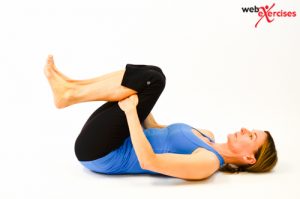
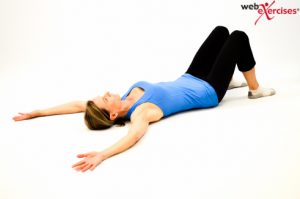
If your client is unable to fully attain this triple flexed position while maintaining their arms above their head on the floor it can be assumed muscles are overactive, limiting their mobility thereby confirming your findings. However if they are able to easily attain a triple flexed position when supine but not when weight bearing, they likely have a strength deficit that prevents them from moving properly when their joints are under load. Therefore, your initial corrective strategy should emphasize either inhibiting or activating muscles depending on your findings.
For the purpose of this article a strategy for the most common dysfunctions will be presented. To begin with, ankle dorsiflexion is essential for proper movement up the kinetic chain. If the heel rises off the ground as the client performs the squat, this may be due to an ankle dorsiflexion limitation of the joint or from an overactive gastrocnemius muscle. Since ankle sprains are one of the most common injuries among active people (6) with the resultant scar tissue formation, both joint mobility and overactive muscles will be addressed.
In order to inhibit and lengthen the gastrocnemius, a self-myofascial release (SMR) approach with either a foam roll or tennis ball can be utilized. SMR using a foam roll has been shown to be effective for increasing flexibility when combined with static stretching. Mohr and colleagues demonstrated this when they compared foam rolling and static stretching of the hamstring muscles. (7) Their study findings indicate using the foam roll for SMR in addition to static stretching is superior to either SMR or static stretching alone. Therefore, in order to maximize range of motion it is recommended to foam roll prior to static stretching.
Gastrocnemius SMR - Lift hips off floor. Slowly move foam roll throughout calf muscle, as tolerated, for 1 to 2 minutes. Maintain consistent pressure. If a tender area is found, stop rolling and REST on the area for 30 seconds, then continue. Repeat 3 times daily.
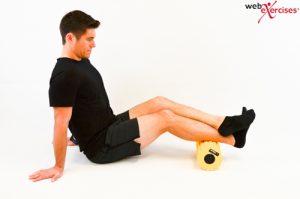
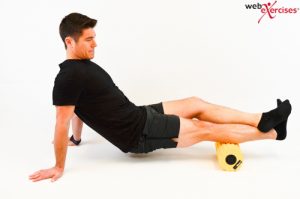
Perform the half kneeling ankle mobilization exercise to address the joint range of motion. This half kneeling position puts the gastrocnemius in a mechanically shortened position eliminating this as a resistive factor. Vencenzo and colleagues demonstrated an increase in dorsiflexion range of motion after a series of mobilization exercises similar to the one described here. (8)
Dorsiflexion Ankle Mobilization - Begin in a half kneeling position with dowel placed by the outside of the forward foot, parallel to shin. Knee should be behind the dowel. Lunge forward keeping the front heel on the floor. Allow the knee to move past the dowel. Keep core activated so as not to hyperextend the low back. Perform 2 sets of 10 repetitions.
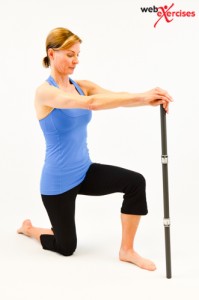
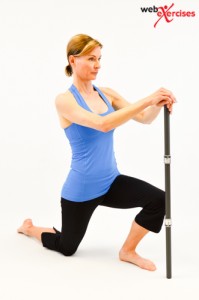
Next, identify if knee valgus is occurring. This dysfunction has been shown as a contributing factor to nearly 40,000 ACL injuries per year. (9) In order to establish lateral stability, the side step “monster walk” with knees bent is a functional and effective exercise. Increased hip abduction strength has been shown to improve the ability of female athletes to control lower extremity alignment. (10) When performing this exercise, the stepping motion should be performed in a squat position rather than an upright straight leg position in order to generate greater gluteus maximus and medius muscle activity. (11)
Lateral Monster Walk - Begin standing with a resistance band around the thighs just above the knees. Keep the feet and knees apart enough to put resistance on the band. Perform a ¼ squat with both feet supporting body weight. Hold squat position, shift weight fully onto one leg. Take a lateral step with the other un-weighted leg. Repeat, taking several lateral steps in one direction and then doing the same in the other direction.
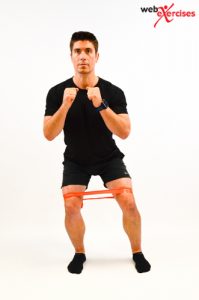
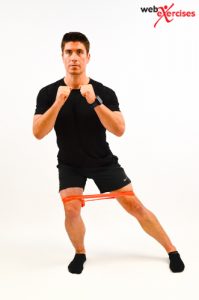
Valgus collapse of the knee can also be the result of weak hip external rotators, as identified by Paterno and colleagues who found an eight times greater risk of sustaining a second ACL injury. (12) Performing the clamshell exercise will assist in mitigating external hip rotator weakness, helping to minimize this potential risk.
Clam Shell with Resistance Band - Begin by lying on the side with knees together and bent to 90 degrees with a resistance band around knees. Lift top knee upward while keeping feet touching. Continue lifting the top knee to the point just before the pelvis begins to move. Perform 3 sets of 10 repetitions on each side.
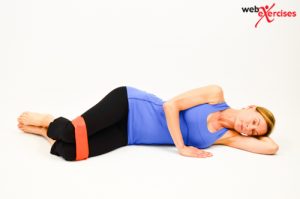
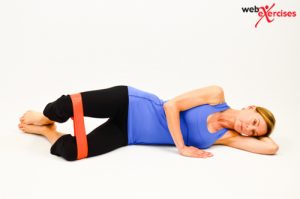
In order to establish better gluteus maximus activation, a hip bridge with a resistance band is recommended. This will also provide further benefit for improved lateral stability as well as pelvic control as demonstrated by Choi and colleagues. They found that gluteus maximus EMG activity was significantly greater while anterior pelvic tilt angle was significantly lower in the hip bridge with isometric hip abduction compared to the hip bridge without the band. Therefore, they concluded that performing hip bridges with isometric hip abduction against isometric elastic resistance can be used to increase gluteus maximus EMG activity and reduce anterior pelvic tilt during the exercise. (13)
Hip Bridge with Resistance Band - Begin by lying on the floor with knees bent and feet flat on the floor. Place a resistance band around the thighs just above the knees. Slightly abduct the legs while simultaneously performing a hip bridge. Slowly lower to start position without bringing knees together. Perform 3 sets of 10 repetitions.
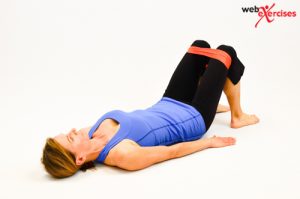
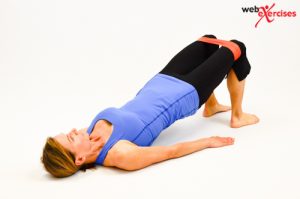
Now that improved gluteal activation has been established, the ability to properly descend while pivoting at the hips and maintaining a correct lumbar position is essential. A hip hinge drill to re-establish the correct motor pattern is done by holding a dowel along the back to cue the client to maintain a neutral spine position.
Hip Hinge - Begin standing with a chair directly behind you. Hold a dowel or similar item along the length of your spine. Stagger feet, placing one foot slightly underneath chair. Maintain neutral spine as you hinge hips, sitting down into the chair. Maintain core activation during entire movement. Upon sitting fully, maintain a neutral spine as you stand up, again paying close attention to maintained core activation. Perform 3 sets of 10 repetitions after which re-assess your client to determine if they are able to perform a proper hip hinge without the dowel. Do not progress them until they can properly perform this movement and adequately control the lumbo-pelvic complex.
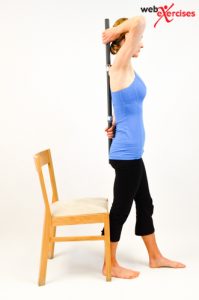
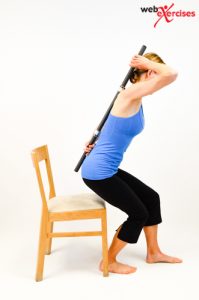
If they continue to have difficulty descending properly, reassessing the posterior chain for overactive and tight hamstring and hip muscles would be appropriate. Then employ stretches as recommended by Kushner and colleagues as well as foam roll SMFR technique previously noted. (14)
Hamstring Foam Rolling – Begin seated on the floor, legs extended with foam roll under the hamstrings. Hands should be placed at sides, supporting the body. Cross one leg over the other and lift hips off of the floor. Gently move foam roll throughout hamstrings, as tolerated, maintaining consistent pressure with foam roll. Perform on each side for 1 minute with a 30 second break to rest your arms.
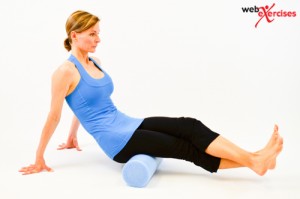
Seated Hamstring Stretch - Begin seated on floor. Extend one leg while the other is flexed inward and adjust to seated position on the sit bones (ischial tuberosities). Maintaining a flat back posture, lean and reach forward until a gentle stretch is felt behind straight leg. Hold for 30 seconds and repeat 3 times on each side.
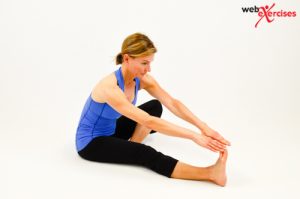
Piriformis Stretch - Begin lying on back. Cross one leg over the other, placing ankle on opposite thigh above knee. Grasp uncrossed leg under thigh and gently pull toward chest. A stretch in the hip of the crossed leg should be felt. Hold for 30 seconds and repeat 2 times on each side.
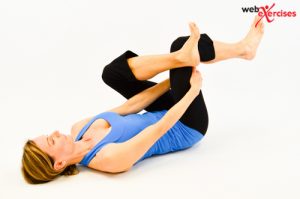
Lastly, the ability to maintain an upright chest and thoracic position with scapula retracted is important to attain a correct lumbo-pelvic position. Performing a static chest stretch on a foam roll is a great way to lengthen tight anterior chest muscles which will then allow proper scapular strengthening to occur.
Foam Roll Chest Stretch - Begin by lying on foam roll with feet flat on the floor. Foam roll should support the head and run along the spine down to the pelvis. Place arms to the sides, bending both elbows to 90º at shoulder level with palms facing up. Relax as chest and shoulders stretch for 30-60 seconds. Do not try to force arms to floor.
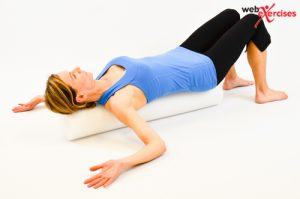
A lack of core stability has also been shown to influence knee injuries in female athletes as reported by Zazulak and colleagues. They demonstrated this decrease in core neuromuscular control increases uncontrolled trunk displacement leading to higher knee ligament strain and ACL injury. (15)
Therefore strengthening the deep spine and major muscles of and around the low back and core is the next step. One of the larger muscles that is integral to the stability of the spine is the quadratus lumborum as noted by McGill and colleagues. They found this muscle was “best suited to be the major stabilizer of the lumbar spine.” They further stated the “side support” or “side bridge” exercise was identified to optimally challenge the quadratus lumborum and the muscles of the abdominal wall while minimizing lumbar spinal loads. (16)
Side Plank - Begin side lying with support forearm directly under the shoulder. Activate the core muscles and lift hips to attain a straight plank position with body weight on forearm. Maintain core contraction. Hold for recommended duration ( e.g., 30 seconds). Repeat for 2 sets on both sides.
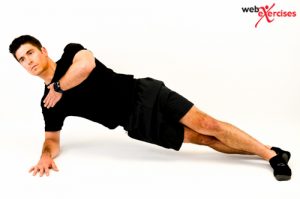
The Blackburn “Y” or horizontal abduction at 100 degree is a great way to re-establish scapular control as this exercise has been shown to elicit high EMG activity of the rotator cuff, deltoid and scapular muscles. (17)
Horizontal Abduction - Begin in a plank position on a stability ball. Arms should be extended to sides at shoulder level with hands at 10 and 2 o'clock position. Make hands into a soft fist with thumbs up. Activate core muscles. Lift hands and arms toward ceiling and squeeze shoulder blades together. Neck muscles should remain relaxed. Hold for 5 seconds. Return to start position and repeat 3 sets of 10 repetitions.
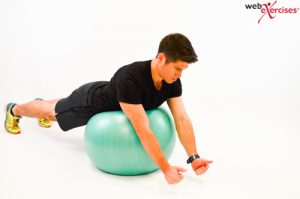
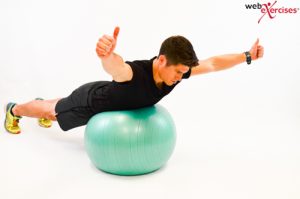
All of the suggested exercises are easy to execute and include minimal risks if performed as described. They are provided as a guideline to some of the most common movement faults identified on an overhead squat assessment. To achieve satisfying results, it is important to do them on a regular basis.
References
- Hewett TE, et al. 2005. Biomechanical measures of neuromuscular control and valgus loading of the knee predict anterior cruciate ligament injury risk in female athletes: a prospective study. Am J Sports Med. 33:492–501.
- Schoenfeld, B. 2010. Squatting Kinematics and Kinetics and Their Application to Exercise Performance. Journal of Strength and Conditioning Research 24(12):3497-3506.
- Fulton, J., et al. 2014. Injury Risk is Alstered by Previous Injury: A Systematic Review of the Literature and Presentation of Causative Neuromuscular factors. International Journal of Sports Physical Therapy. 9(5):583-595.
- Hewett, T., et al. 2013. Current Concepts for Injury Prevention in Athletes After Anterior Cruciate Ligament Reconstruction. Am J Sports Med. 41(1): 216–224.
- Clark, M.A., Lucett, S.C. (2014). NASM Essentials of Corrective Exercise Training. Burlington, MA. Jones & Bartlett Learning.
- Fong D., et al. 2007. A systematic review on ankle injury and ankle sprain in sports. Sports Med 37(1):73–94.
- Mohr, A., et al. 2014. Effect of foam rolling and static stretching on passive hip-flexion range of motion. Journal of Sport Rehabilitation.
- Vincenzino, B., et al. 2006. Initial Changes in Posterior Talar Glide and Dorsiflexion of the Ankle After Mobilization With Movement in Individuals With Recurrent Ankle Sprain. J Orthop Sports Phys Ther. 36(7):464-471.
- de Loes, M., et al. R. A 7-year study on risks and costs of knee injuries in male and female youth participants in 12 sports. Scand J Med Sci Sports. 10(2):90-97.
- Myer , G. et al. 2008. Trunk and Hip Control Neuromuscular Training for the Prevention of Knee Joint Injury. Clin Sports Med 27:425–448.
- Berry et al. 2015. Resisted side-stepping: the effect of posture on hip abductor muscle activation. Journal of Orthopaedic & Sports Physical Therapy.
- Paterno, M. et al. Biomechanical Measures During Landing and Postural Stability Predict Second Anterior Cruciate Ligament Injury After Anterior Cruciate Ligament Reconstruction and Return to Sport. Am J Sports Med October 2010 vol. 38 no. 10 1968-1978.
- Choi, C., et al. 2014. Isometric hip abduction using a Thera-band alters gluteus maximus muscle activity and the anterior pelvic tilt angle during bridging exercise. Journal of Electromyography and Kinesiology.
- Adam M. Kushner The Back Squat Part 2: Targeted Training Techniques to Correct Functional Deficits and Technical Factors that Limit Performance.
- Zazulak BT, Hewett TE, Reeves NP, et al. The effects of core proprioception on knee injury: a prospective biomechanical–epidemiological study. Am J Sports Med 2007;35(3):368–73.
- McGill, S., et al. 1999. Endurance Times for Low Back Stabilization Exercises: Clinical Targets for Testing and Training From a Normal Database . Arch Phys Med Rehabil Vol 80.
- Escamilla, R., et al. Sports Med 2009; 39 (8): 663-685.
















